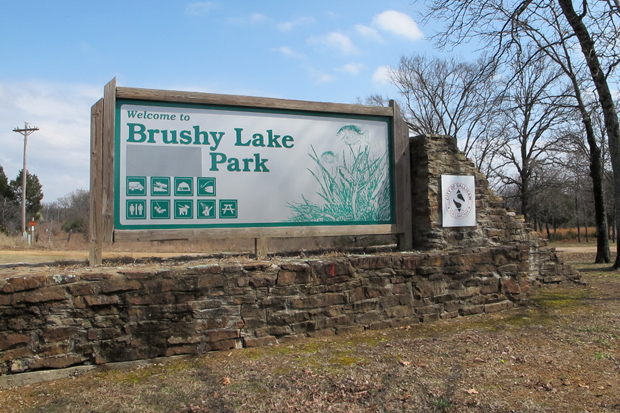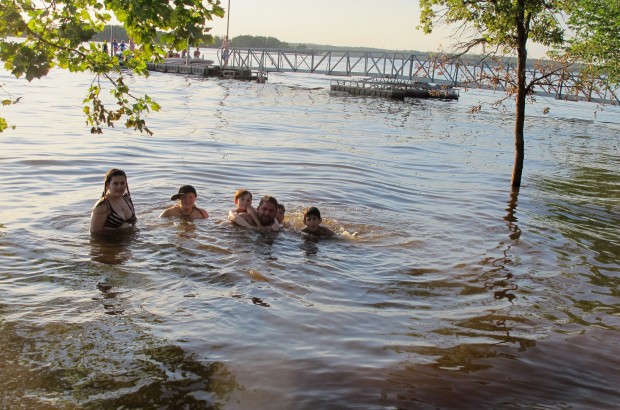
The word 'state' has been removed from Brushy Lake Park's entrance sign. The park, near Sallisaw, Okla., was transferred to the city's control in 2011.
Logan Layden / StateImpact Oklahoma


The word 'state' has been removed from Brushy Lake Park's entrance sign. The park, near Sallisaw, Okla., was transferred to the city's control in 2011.
Logan Layden / StateImpact Oklahoma

Logan Layden / StateImpact Oklahoma
Justin Stratford and several of his nieces and nephews play in Lake Thunderbird on a road trip from Arizona.
The $7.1 billion state budget Governor Mary Fallin signed in June 2015 included deep cuts to the Oklahoma Department of Tourism and Recreation — the agency that runs the state park system. That could mean some parks will have to be closed or transferred to new operators, and some eastern Oklahoma lawmakers are fuming.
Generally, these parks aren’t big money makers for the state. Lake Thunderbird State Park near Norman is one of the most expensive parks the state runs. A little more than half a million people visited the park in 2013, and the park brought in about half a million dollars. But it cost $1.2 million to run. State funding makes up the difference, and that’s one reason why people who enjoy state parks in Oklahoma might be worried.
Lake Thunderbird isn’t likely to close, even though the state loses money on it. It’s well attended and the only state park in the Oklahoma City metro. But these are uncertain times at the Tourism Department.
“The executive director and the chief financial officer have been meeting everyday, and have been working on a budget everyday, and it’s still being worked on is all I can say,” says Claudia Conner, deputy director of the Oklahoma Department of Tourism and Recreation..
Conner says the 5 percent cut to the agency’s funding from the legislature only tells part of the story.
“That’s only part of the cut, which is approximately $1 million,” Conner says. “There were also cuts to apportionment of $7.8 million, and some of the Tourism funds were swept, so to speak, at $7.5 million.”
She’s talking about reductions in the amount of use and sales tax money that’s set aside for tourism, and cuts to two of the agency’s revolving funds that usually pay for park maintenance and travel promotion. When you add it all up, the agency is losing more than $16 million.
“Which is on top of approximately 26 percent cuts that have happened in the past several years,” she says.
That’s not even considering the cost of repairing all the recent flood damage at several parks. Since 2011, budget cuts have forced the Department of Tourism to stop funding parks and transfer them to new owners. State Rep. Johnny Tadlock, D-Idabel, sits on the House Tourism Committee, and predicts more parks will be offloaded.

Logan Layden / StateImpact Oklahoma
The word 'state' has been removed from Brushy Lake Park's entrance sign. The park, near Sallisaw, Okla., was transferred to the city's control in 2011.
“How are they going to sustain those sort of cuts?” Tadlock asks. “It doesn’t take some big economist to, kind of, put the pencil to that and figure it out. How are they going to keep running, you know? They’re not.”
Tadlock voted against the budget bill this year, and so did Rep. Brian Renegar, D-McAlester. He has harsh words for the Tourism Department under Gov. Fallin, and specifically, Deby Snodgrass, who Fallin appointed as director of the agency in 2011, and secretary of commerce and tourism earlier this year.
“She’d been a bean counter for an oil company in her previous life,” Renegar says. “And she thinks for some reason that our parks should make money, and that’s not what they were built for. State parks were built to stimulate economic development in the rural areas.”
There are definitely two different philosophies on parks. But while the number of parks has shrunk during Snodgrass’ tenure at Tourism, Claudia Conner says there’s no conspiracy to shut down the system in the name of smaller government.
“I find that odd, because the parks that were transferred, not closed, were on Governor Brad Henry’s list of — in his budget book, prior to this administration — parks that should be considered for closure,” Conner says. “So, I don’t understand that reasoning.”
But park philosophies aside, the big question now is which parks — if any — the state agency might shed because of the most recent cuts to its budget, which go into effect on July 1.
“I can’t tell you right now what’s going to happen in the future,” Conner says. “It wasn’t until less than a month ago — just a couple of weeks ago — that we got the information about the exact budget cut.”